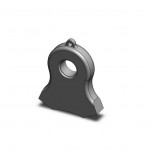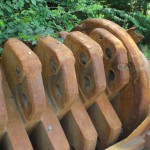Hammer Patterns for Disk Rotors
Scrap metal shredder operators have many hammer patterns and methods for extending hammer wear life. Disk rotors offer more combinations than spider rotors for most operators.
Disk rotors come in 10 or 11 disk models, often with 6 pin positions. You can use a 10, 12, or 14 hammer pattern to meet your production requirements. The balance of the openings are filled by pin protectors. Proper rotation of the hammers to different positions is the key to longer wear life and consistent production levels.
Some operators rotate in a few new hammers each maintenance cycle and keep mill output consistent. Others run in sets. They rotate edges and positions to achieve maximum hammer wear, then replace the set. Extra hammers on the end positions help move material away from the side liners to reduce wear. Extra hammers in the center position are preferred at times to get more work edges where the action is.
The pattern and rotation that works best depends on these factors:
- Feedstock mix
- Side liner wear
- Wear pattern on bottom grates
- Unusual wear on the rotor
Extra hammers benefit mills shredding a high percentage of sheet iron and appliances. If shredding auto bodies, fewer hammers often yield positive results. Too many hammers will impede the ability of scrap to enter the shredder, thus the upper limit of about 14 hammers mentioned earlier. Wear on liners and grates indicate the work area. Changing hammer positions can help distribute the material load to some degree. High wear on your inner disks may indicate you are letting hammers and pin protectors wear too long.
As mentioned in the spider rotor post, finding your ‘sweet spot” requires a little experimentation and measurement. If you can maintain density and recovery and use less new hammers, you’re moving in the right direction of controlling overall cost. Don’t ignore wear parts life. Casting costs are as real as your electric or fuel bills each month.

 many potential positions, in the majority of applications it is best in terms of performance and reduced wear parts cost, to use fewer
many potential positions, in the majority of applications it is best in terms of performance and reduced wear parts cost, to use fewer 


